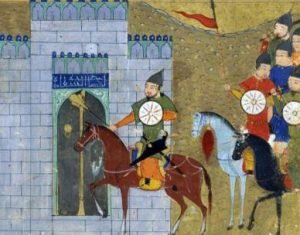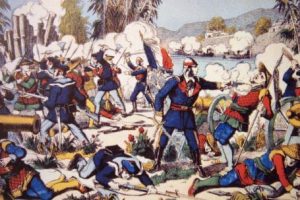History of Vietnam
Contents
Mythological origin of the Vietnamese people
When you ask the Vietnamese about their origin, almost all respond that the Viet people are born of the union of the Dragon and the Fairy. We know that this is a non-scientific explanation and difficult to prove historically, but the power of that myth has made the Vietnamese internalize this legend within their society. The myths of this country are a matter of faith that no evidence can ever change.

Although Vietnam has embraced all kinds of religions (Buddhism, Catholicism, Protestantism, Taoism, Animists …) the inhabitants are convinced that all come from the same source, from the same uterus, and therefore call themselves Đồng bào (born of the same womb). It is this power of Vietnamese myths that has sustained the Viet people throughout their history, which keeps them united despite differences.
According to Vietnamese myth and history, the first Viet descended from the Dragon Lạc Long Quân and the immortal Hada Âu Cơ. These two celestial beings had 100 children. 50 children went to the mountains with their mother, and the other 50 went with their father to the sea. The eldest son became the first king of a saga known as the Hung, the kings (in almost every city of Vietnam there is a street called Hùng Vương). The Hung gave the name of Văn Lang to a settlement that at that moment was located on the banks of the Red Delta, that is to say in the North of Vietnam, and its inhabitants called themselves Lạc Việt. After the last King Hung was conquered (258 BCE), King And Duong Vuong moved the ancient Capital that was in the mountains, to Co Loa 15 km away from Hanoi. The citadel was attacked several times until they managed to conquer it.
The union of the descendants of Hung (Lac Viet), and those of An Duong Vuong (Au Viet), created the reign of Au Lac.
The Chinese Domination
Vietnam has been conquered by China for more than a millennium. Chinese domination began in 111 BC, when they seized Vietnam (then southern China but Vietnamese Village, which is said to be the southern Viet) that is Nanyue.
Nanyue, but called by the Vietnamese Nam Việt (South Vietnamese), was a kingdom of Asia and comprised the present Chinese provinces Guangdong, Guangxi and Yunnan, and also comprised a part of the present North of Vietnam. Nanyue or Nam Viet is founded by General Chino Zhao Tuo. This general conquers Au Lac, that is, conquers the Vietnamese living in southern China.
The Viet identity
But little by little an awareness of Viet identity is forged, and in 939, the country became independent even though the new Đại Việt or great Vietnam coexisted to a certain extent with the Chinese domination and yields to pay some taxes, so it was still a vassal state until the Viet began their expansion through a process called Nam Tiên, the march to the south. From the 10th century to the 15th century the Viet, the children of Au Lac grew larger, from the north to the south. They coexist with the Cham Champa reign who in the end accepted the domination of the Viet. They also conquered the Mongols and Khems settled in the present Vietnamese territory.

Lê Lợi (Reigned from 1428-1433) rose to victory against the Chinese occupation, and settled in the citadel of Thang Long (Acutal Hanoi), The Ascending Dragon. Thang Long was also known as Đông Kinh (東京), which means ‘Capital of the East’. (東京 Identical meaning and the same spelling as Tokyo in the Chinese language)
Vietnam experienced about 900 years of struggle for independence and expansion towards the south governed by different national leaders.
At the end of the sixteenth century it can be said that the country was divided between the Trinh family that dominated the south and the Nguyen family that dominated the North. The Nguyễn ended up ruling the whole country that calls itself Việt Nam, but known in the West by the name of Annam.
French colonization
Like China, Vietnam is also the victim of Western incursions: in 1862, France seized Conchinchina, the southern part of Vietnam. In the 1880s, Tonkin’s expedition allowed the French Republic to conquer Vietnamese territory, and that territory under Nguyen’s control was subject to a regime of double protectorate that divided the country administratively in two.
The ancient kingdom of Annam is divided into three entities, all under French control: the colony of Conchinchina and the protectorates of Tonkin and Annam.
In 1887, these regions are integrated into French Indochina. The Nguyễn will remain governors but only in a symbolic way.
1939: French Indochina had military forces incapable of facing a serious threat from outside, but capable of securing internal order. In Vietnam, the communist party was dissolved and its pursued members, the Trotskyists, were eliminated. They secretly took refuge in China, and from there, the survivors prepared the independence of colonialism imposed by Japan and France. World War II becomes a parable of French domination in Indochina.
The Independence of Vietnam
In September 1941, Nguyen Ai Quoc, a convert to Ho Chi Minh, created the Vi Nam Nam Lap Lap Dong Minh (Vietminh) or league for Vietnam’s independence, in order to fight against “Japanese and French fascisms”, their supporters controlled Northern Tonkin.
Japan failed in its attempt to sweep through Indochina, and created an irreversible situation by relying on the nationalists. The Viet Minh, the Indochina Communist Party-led independence movement led by Ho Chi Minh, takes advantage of the Japanese incursion to regain power over a part of Vietnamese territory and proclaims Vietnam Independence. Emperor Bao Dai proclaimed Vietnam’s independence under Japanese control, but in August 1945 the Japanese capitulation allowed the Communists to take control of the country, later Bao Dai abdicated. Ho Chi Minh formed a provisional government and on 2 September 1945 proclaimed the republic.

After the war of liberation against Japan, the Vietnamese confronted France returning to recover their lost territories with the Japanese invasion. General De Gaulle, anxious to establish French sovereignty in Indochina, sent an expeditionary body of 70,000 men under General Leclerc. The French attempted to regain their colonies but did not have enough strength or international support to meet the wishes of the Viet Independence. On March 13, 1954, the Battle of Dien Bien Phu began when General Giap decided to respond to the French offensive with a well-organized army. The attack began with the deployment of the Vietnamese artillery, which was surprising for the French who suffered an attack with nine thousand bombs during the first day. The artillery had been transported by the Vietnamese, piece by piece, dragged by hand or cycled through the mountains and then reassembled in the positions occupied by the Vietminh. During the crossing some died from the exhausting effort.
In 1954, the French withdrew from Indochina. The battle of Dien Bien Phu was the first of the 20th century, when a European colonial power was defeated by the national liberation forces in a conventional tactic and France was the second European power to be defeated, behind Spain.
The Vietnamese victory meant the end of the war and led to the signing of the Geneva agreements, where Vietnam was divided in two by the 17th parallel: North Vietnam under the government of Ho Chi Minh and South Vietnam, under the command of Emperor Bao Dai, also agreeing to the call for elections two years later in which the country’s reunification would be decided, which would never happen because the ruler of South Vietnam Ngo Dinh Diem, successor of the Emperor Bao Dai with the support of the United States, disregarded that point of the agreements, and implemented a dictatorship and began to persecute harshly all the opposition: Buddhists, caodaists and communists with which the conflict restarted in 1958, which would later be known as the Vietnam War.
Vietnam War
For the United States, migration from the northern Viet to the South was an aid to its international propaganda, generating wide coverage of the Vietnamese’s flight from communist oppression to the Free World under US auspices.
This period was marked by the CIA propaganda campaign on behalf of the Prime Minister of South Vietnam, Catholic Ngo Dinh Diem. The campaign urged Catholics to flee religious repression from the communist regime, which about 60% of Catholics were living in the north.
The North was led by the communist regime of the Democratic Republic of Viet Nam, and the South was headed by the so-called Republic of Viet Nam. Hostility between the two states causes the North to want to regain the south and the Viet Cong insurrection . This gave rise to the most decisive participation of the United States and the consequent War that we have all known as the Vietnam War, but which the Vietnamese know as the United States War. A bloody and cruel military and civil confrontation that took place in Vietnam from 1959 to 1975. The United States and 40 other countries supported South Vietnam, while the Union of Soviet Socialist Republics (USSR) and the People’s Republic of China supplied ammunition to North Vietnam and the Vietcong.

In the North Vietnamese side they had 10 times as many deaths as the South. Even so, after the end of the war, with the armistice between the south and the north, the Vietnam War was marked by morale and public opinion as the first defeat in US military history.
Nixon, president of the United States signed in Paris the end of the war and the retirement of the American armies (1975)
The Vietnamese from the north reached the south, unified the nation and declared Hanoi the capital of the People’s Republic of Viet Nam; Saigon capital of the South is called today, Ho Chi Minh City in honor to its leader.
Consequences of the Vietnam War
In United States:
- Opposition to the war spread within and outside the United States among youths, being one of the causes of movement against the system, creating the hippie movement.
- The war left hundreds of thousands of drug addicted soldiers affected by the orange agent used during the war.
- US universities were staging protest demonstrations against the implication of the United States in this war.
- There was Vietnam syndrome in which the United States lost its spirit of liberating and winning nations. Thousands of disabled, amputees, paralyzed and mentally disturbed.
In Vietnam
- The former North Vietnam lost 70% of its industrial and transport infrastructure, in addition to 3,000 schools, 15 university centers and 10 hospitals.
- The Vietnamese environment was deeply damaged by the utilization of the orange agent that defoliated large areas of jungle.
- The use of orange agent and other chemical weapons affected the population and continues to affect thousands of premature abortions, sterility and births with malformations.
- Thousands of peasants and refugees affected the country’s economy.
A large number of mined areas that continue to affect the country’s farmers.
